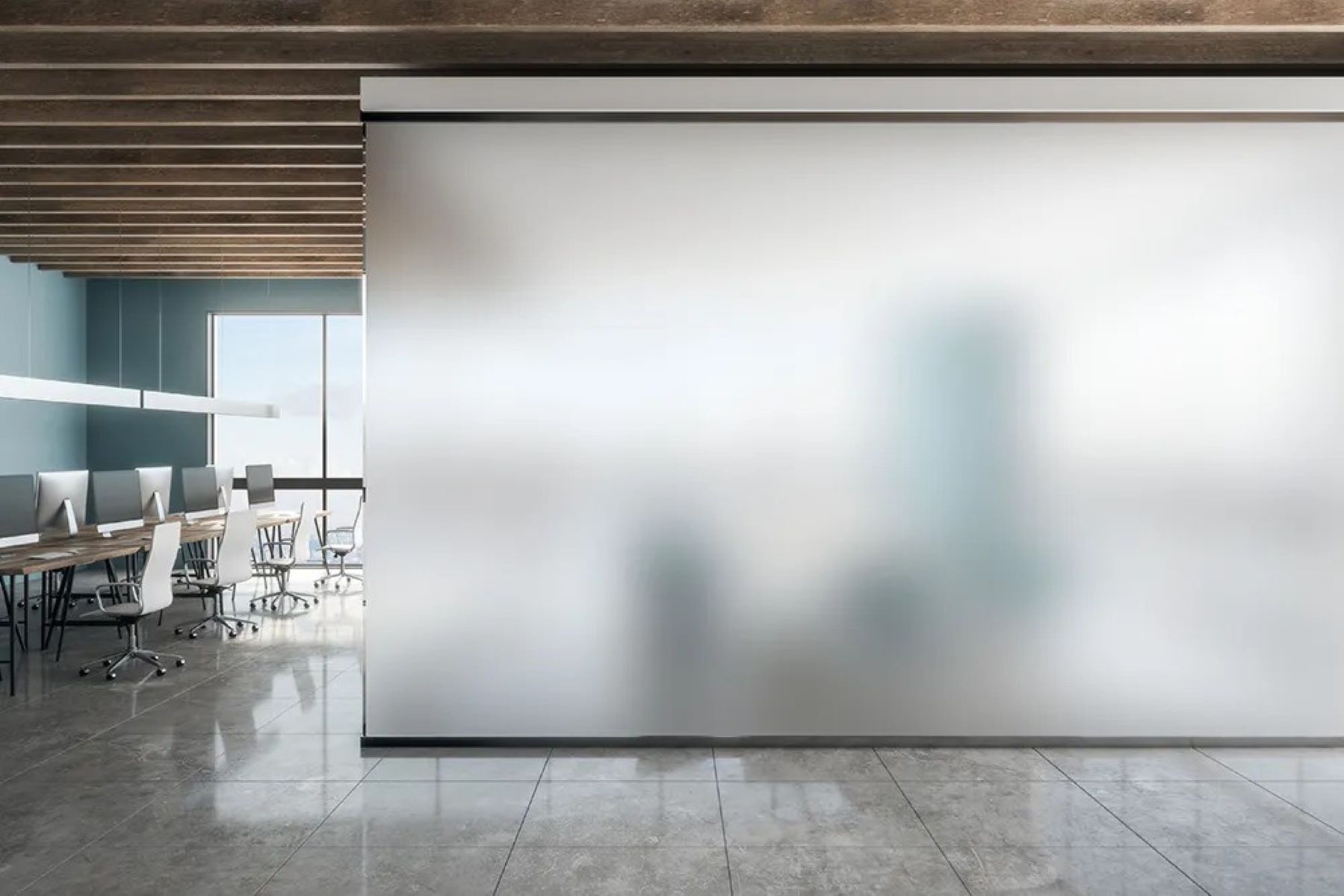Home>Furniture & Design>Interior Design Trends>How Does Privacy Glass Work


Interior Design Trends
How Does Privacy Glass Work
Modified: February 18, 2024
Discover how privacy glass works and its impact on interior design trends. Learn about the innovative technology behind privacy glass and its applications.
(Many of the links in this article redirect to a specific reviewed product. Your purchase of these products through affiliate links helps to generate commission for Storables.com, at no extra cost. Learn more)
Introduction
Privacy glass, also known as switchable glass or smart glass, is a revolutionary innovation that has transformed the way we perceive and utilize glass in architectural and interior design. This cutting-edge technology offers the unique ability to switch between transparent and opaque states, providing privacy and control over light transmission with just a flick of a switch or the push of a button.
The integration of privacy glass into modern design concepts has opened up a world of possibilities, allowing for dynamic and adaptable spaces that cater to diverse needs and preferences. Whether it's in residential, commercial, or hospitality settings, privacy glass has become a sought-after solution for enhancing privacy, optimizing natural light, and adding a touch of sophistication to interiors.
As we delve into the intricacies of privacy glass, we'll explore its functionality, the different types available, and the fascinating mechanisms that enable it to transition seamlessly between transparency and opacity. Furthermore, we'll uncover the diverse applications of privacy glass across various industries and examine the advantages it offers, along with the considerations that come into play when incorporating this innovative material into design projects.
Key Takeaways:
- Privacy glass, also known as smart glass, can switch between transparent and opaque states, offering instant privacy and light control with just a flick of a switch. It’s like magic for your windows!
- There are different types of privacy glass, like electrochromic and thermochromic glass, each with unique ways of changing from see-through to solid. It’s like having superpowers for your windows!
Read more: How Does Polarized Glass Work
What is Privacy Glass?
Privacy glass, also referred to as switchable glass or smart glass, is a technologically advanced glazing material that possesses the remarkable ability to transition from a transparent to an opaque state, offering instantaneous privacy and light control. This innovative glass solution is engineered to meet the evolving needs of modern architecture and interior design, providing a versatile and dynamic alternative to traditional static glass panels.
At its core, privacy glass is designed to offer a transformative experience, allowing spaces to adapt to varying privacy requirements and lighting conditions with seamless efficiency. The fundamental principle behind privacy glass lies in its ability to alter its visual properties in response to external stimuli, such as electrical voltage, heat, or light. This transformative capability is made possible through the integration of cutting-edge technologies, including liquid crystal, suspended particle, and electrochromic technologies, each offering unique benefits and applications.
Privacy glass serves as a multifaceted solution that transcends conventional limitations, offering a balance between openness and seclusion, while also enhancing the aesthetic appeal of interior spaces. Its versatility extends to a wide range of settings, including residential homes, corporate offices, healthcare facilities, hospitality venues, and retail environments, where the need for adaptable privacy solutions is paramount.
In essence, privacy glass represents a fusion of innovation and functionality, redefining the boundaries of traditional glass applications and paving the way for dynamic, interactive environments. By seamlessly transitioning between transparent and opaque states, privacy glass empowers designers and occupants to curate spaces that cater to their specific privacy and lighting preferences, fostering a harmonious blend of form and function.
The evolution of privacy glass continues to inspire new possibilities in architectural and interior design, offering a glimpse into the future of interactive and adaptive built environments. As this transformative technology gains momentum, its potential to redefine spatial experiences and elevate design aesthetics remains a compelling force in shaping the landscapes of tomorrow.
Types of Privacy Glass
Privacy glass encompasses a diverse array of innovative solutions, each offering unique functionalities and applications to cater to varying design requirements and preferences. The evolution of privacy glass technology has given rise to several distinct types, each distinguished by its underlying mechanisms and operational characteristics. These types include:
1. Electrochromic Glass
Electrochromic glass, also known as electronically tintable glass, utilizes a thin film coating that responds to electrical voltage to initiate a reversible color change. When a low voltage is applied, the glass transitions from a transparent state to a tinted or opaque state, effectively controlling the amount of light and heat transmission. This type of privacy glass offers seamless and precise control over transparency, making it an ideal choice for energy-efficient building designs and dynamic light management.
2. Suspended Particle Device (SPD) Glass
SPD glass incorporates microscopic light-absorbing particles suspended within a polymer matrix. By applying an electrical charge, the orientation of these particles can be manipulated, allowing the glass to transition from a clear to a darkened state. This dynamic adjustment of opacity enables SPD glass to effectively modulate light transmission and solar heat gain, contributing to enhanced comfort and energy savings in architectural applications.
Read more: How Does Smart Glass Work
3. Polymer Dispersed Liquid Crystal (PDLC) Glass
PDLC glass features a laminated construction with a polymer matrix containing liquid crystal droplets. When an electrical current is applied, the orientation of the liquid crystal molecules changes, causing the glass to transition from transparent to opaque. This type of privacy glass offers instantaneous privacy control and can be integrated into partitions, windows, and display screens, adding a layer of versatility to interior spaces.
4. Thermochromic Glass
Thermochromic glass is engineered with materials that undergo a reversible color change in response to temperature variations. As the ambient temperature fluctuates, the glass shifts between transparent and opaque states, providing a passive yet effective means of privacy control. This type of privacy glass is particularly well-suited for applications where natural environmental conditions can be leveraged to regulate transparency and enhance visual comfort.
5. Photochromic Glass
Photochromic glass incorporates light-sensitive molecules that undergo a reversible transformation in response to ultraviolet radiation. When exposed to sunlight, the glass darkens to mitigate glare and solar heat gain, offering a dynamic solution for optimizing daylighting and reducing the reliance on artificial lighting. This type of privacy glass seamlessly adapts to changing light conditions, promoting a balanced and sustainable approach to interior illumination.
The diverse range of privacy glass types underscores the versatility and adaptability of this transformative technology, presenting designers and architects with a spectrum of options to tailor privacy solutions to specific project requirements. By harnessing the unique capabilities of each type, privacy glass continues to redefine spatial experiences and elevate the standards of modern design, paving the way for dynamic and responsive built environments.
How Does Privacy Glass Switch from Transparent to Opaque?
The remarkable transition of privacy glass from a transparent to an opaque state is made possible through the integration of advanced technologies that harness the principles of light manipulation and material responsiveness. The specific mechanisms employed by different types of privacy glass play a pivotal role in orchestrating this transformative process, offering a seamless and dynamic shift in visual properties.
Electrochromic glass, for instance, relies on the electrochromic effect, where the application of a low voltage triggers the migration of ions within the glass, causing a reversible change in color and transparency. This electrochemical reaction enables the glass to transition from a clear state to a tinted or opaque state, providing precise control over light transmission and privacy. The activation of this electrochromic process is facilitated by a sophisticated control system, allowing users to modulate the opacity of the glass with ease.
In the case of suspended particle device (SPD) glass, the transition from transparency to opacity is achieved through the manipulation of microscopic light-absorbing particles suspended within the glass. By applying an electrical charge, the orientation of these particles is altered, resulting in a rapid adjustment of opacity. This dynamic reconfiguration of particle alignment enables SPD glass to swiftly adapt to changing privacy requirements, offering a responsive solution for light management and visual privacy.
Similarly, polymer dispersed liquid crystal (PDLC) glass leverages the unique properties of liquid crystal molecules embedded within a polymer matrix. When an electrical current is applied, the orientation of these molecules changes, causing the glass to transition from a transparent to an opaque state. This instantaneous transformation is orchestrated by the activation of the electrical control system, enabling users to customize the level of opacity based on their specific privacy needs.
Thermochromic and photochromic glass, on the other hand, harness environmental stimuli to regulate their transparency. Thermochromic glass undergoes a reversible color change in response to temperature fluctuations, while photochromic glass adapts to varying levels of ultraviolet radiation. These inherent responsiveness to environmental cues allows these types of privacy glass to autonomously modulate their opacity, offering a passive yet effective approach to privacy control.
The seamless transition of privacy glass from transparency to opacity underscores the ingenuity and adaptability of these advanced materials, presenting a dynamic solution for privacy management and light modulation. By harnessing the principles of electrochemistry, material science, and environmental responsiveness, privacy glass continues to redefine the boundaries of traditional glazing, offering a glimpse into the future of interactive and adaptive built environments.
Read more: How Does A Glass Door Works
Applications of Privacy Glass
Privacy glass has transcended traditional boundaries, offering a versatile and dynamic solution for a wide spectrum of applications across diverse industries. Its transformative capabilities and adaptive nature have positioned it as a sought-after material in architectural and interior design, revolutionizing the way spaces are conceived and experienced. From residential settings to commercial environments, healthcare facilities, hospitality venues, and beyond, privacy glass has found compelling applications that redefine spatial experiences and elevate the standards of modern design.
In residential contexts, privacy glass serves as a pivotal element in creating adaptable living spaces that cater to the evolving needs of occupants. From bathroom enclosures and shower screens to interior partitions and dynamic windows, privacy glass offers a seamless transition between openness and seclusion, enhancing the functionality and aesthetic appeal of residential interiors. Its ability to provide instant privacy control while optimizing natural light transmission makes it an ideal choice for modern homes seeking a balance between functionality and style.
In commercial and corporate settings, privacy glass emerges as a versatile solution for enhancing privacy and productivity. From conference room partitions and office enclosures to interactive display screens and facade elements, privacy glass fosters an environment of flexibility and sophistication. Its capacity to transform spaces on demand, creating private meeting areas or open collaborative zones, aligns with the dynamic nature of modern workplaces, promoting a harmonious blend of privacy and connectivity.
Healthcare facilities benefit from the adaptive nature of privacy glass, utilizing it in patient rooms, treatment areas, and medical office spaces. The ability to instantly transition between transparent and opaque states ensures patient privacy and comfort while facilitating visual access for medical staff. This dynamic approach to privacy management contributes to a healing environment that prioritizes both privacy and transparency, fostering a sense of reassurance and well-being for patients and healthcare professionals alike.
In the hospitality industry, privacy glass adds a touch of sophistication and functionality to guest rooms, spa facilities, and communal areas. Its seamless transition between transparency and opacity allows for customizable privacy settings, creating an immersive and personalized experience for guests. Whether used in shower enclosures, room dividers, or interactive display features, privacy glass elevates the ambiance of hospitality spaces, offering a blend of privacy and visual allure.
Beyond these specific applications, privacy glass continues to inspire innovative solutions in retail environments, educational institutions, and public venues, where the need for adaptable privacy solutions intersects with the pursuit of dynamic and engaging spatial experiences. Its capacity to redefine spatial boundaries and transform the dynamics of interior environments positions privacy glass as a transformative material that continues to shape the landscapes of modern design.
The diverse applications of privacy glass underscore its versatility and adaptability, presenting a compelling case for its integration into a wide range of design contexts. As this transformative technology continues to evolve, its potential to redefine spatial experiences and elevate design aesthetics remains a compelling force in shaping the landscapes of tomorrow.
Benefits and Drawbacks of Privacy Glass
Privacy glass offers a myriad of benefits that have redefined the possibilities of architectural and interior design. Its transformative capabilities and dynamic nature have positioned it as a sought-after material in various industries, from residential to commercial and healthcare settings. However, alongside its advantages, privacy glass also presents certain considerations that warrant attention.
Benefits
-
Adaptive Privacy Control: Privacy glass provides instantaneous privacy control, allowing spaces to seamlessly transition between transparent and opaque states. This adaptability empowers users to tailor privacy settings according to their specific needs, fostering a dynamic and responsive environment.
-
Enhanced Natural Light: By optimizing light transmission, privacy glass contributes to the efficient utilization of natural light, reducing the reliance on artificial lighting and promoting energy efficiency. This not only creates a visually inviting ambiance but also supports sustainable design practices.
-
Space Optimization: The versatility of privacy glass enables the creation of multifunctional spaces, where the boundaries between open and private areas can be dynamically redefined. This flexibility enhances spatial efficiency and promotes a seamless flow within interiors.
-
Aesthetic Versatility: Privacy glass adds a touch of sophistication to interiors, offering a sleek and modern aesthetic that complements contemporary design concepts. Its seamless integration into various architectural elements elevates the visual appeal of spaces.
Drawbacks
-
Cost Considerations: The implementation of privacy glass may entail higher upfront costs compared to traditional glazing solutions. The integration of advanced technologies and specialized manufacturing processes contributes to its initial investment.
-
Maintenance and Durability: Certain types of privacy glass may require specific maintenance procedures to ensure optimal performance and longevity. Understanding the maintenance requirements is essential for preserving the functionality of privacy glass over time.
-
Technological Dependencies: The operation of privacy glass is reliant on electrical systems or environmental stimuli, such as temperature or light. This technological dependency necessitates a comprehensive understanding of the control mechanisms and potential backup measures.
-
Installation Complexity: Depending on the type and scale of the project, the installation of privacy glass may involve complexities that require professional expertise. Proper installation is crucial for maximizing the performance and longevity of privacy glass applications.
In weighing the benefits and drawbacks of privacy glass, it becomes evident that its transformative capabilities offer compelling advantages for enhancing spatial experiences and design aesthetics. By addressing the considerations associated with its implementation, privacy glass continues to redefine the boundaries of traditional glazing, presenting a dynamic and responsive solution for modern design challenges.
Read more: How Does Bulletproof Glass Work
Conclusion
In conclusion, privacy glass stands as a testament to the convergence of innovation and functionality, redefining the boundaries of traditional glazing and offering a dynamic solution for privacy management and light modulation. The transformative capabilities of privacy glass have reshaped the landscape of architectural and interior design, empowering designers and occupants to curate spaces that seamlessly adapt to varying privacy requirements and lighting conditions.
The diverse range of privacy glass types, including electrochromic, suspended particle device (SPD), polymer dispersed liquid crystal (PDLC), thermochromic, and photochromic glass, underscores the versatility and adaptability of this transformative technology. Each type offers unique functionalities and applications, catering to specific project requirements and design preferences. From residential homes to commercial offices, healthcare facilities, hospitality venues, and beyond, privacy glass has found compelling applications that redefine spatial experiences and elevate the standards of modern design.
The benefits of privacy glass, such as adaptive privacy control, enhanced natural light, space optimization, and aesthetic versatility, have positioned it as a sought-after material in various industries. However, considerations regarding cost, maintenance, technological dependencies, and installation complexity warrant attention to ensure the successful integration of privacy glass into design projects.
As privacy glass continues to evolve, its potential to redefine spatial experiences and elevate design aesthetics remains a compelling force in shaping the landscapes of tomorrow. The seamless transition of privacy glass from transparency to opacity underscores the ingenuity and adaptability of these advanced materials, presenting a dynamic solution for privacy management and light modulation.
In essence, privacy glass represents a fusion of innovation and functionality, offering a glimpse into the future of interactive and adaptive built environments. Its transformative capabilities have redefined the possibilities of architectural and interior design, paving the way for dynamic and responsive solutions that cater to the evolving needs of modern spaces. As this transformative technology gains momentum, its potential to reshape the way we perceive and interact with built environments remains a driving force in the evolution of design and technology.
Frequently Asked Questions about How Does Privacy Glass Work
Was this page helpful?
At Storables.com, we guarantee accurate and reliable information. Our content, validated by Expert Board Contributors, is crafted following stringent Editorial Policies. We're committed to providing you with well-researched, expert-backed insights for all your informational needs.













0 thoughts on “How Does Privacy Glass Work”